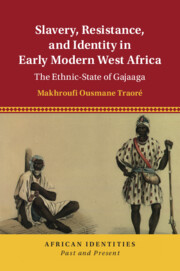Book contents
- Slavery, Resistance, and Identity in Early Modern West Africa
- African Identities: Past and Present
- Slavery, Resistance, and Identity in Early Modern West Africa
- Copyright page
- Contents
- Figures
- Tables
- Preface
- Acknowledgement
- Introduction
- Part I Between the Sahara and the Atlantic Ocean
- 1 The Ethnic State of Gajaaga
- 2 African Slavery versus the Slave Trade(s)
- Part II Atlantic Slavery, Kingship, and Worship of Nature
- Part III Gajaaga at the Center, the French Empire at the Edges
- Conclusion
- Bibliography
- Index
2 - African Slavery versus the Slave Trade(s)
Social Stratification Is Not Merchant Slavery
from Part I - Between the Sahara and the Atlantic Ocean
Published online by Cambridge University Press: 16 November 2023
- Slavery, Resistance, and Identity in Early Modern West Africa
- African Identities: Past and Present
- Slavery, Resistance, and Identity in Early Modern West Africa
- Copyright page
- Contents
- Figures
- Tables
- Preface
- Acknowledgement
- Introduction
- Part I Between the Sahara and the Atlantic Ocean
- 1 The Ethnic State of Gajaaga
- 2 African Slavery versus the Slave Trade(s)
- Part II Atlantic Slavery, Kingship, and Worship of Nature
- Part III Gajaaga at the Center, the French Empire at the Edges
- Conclusion
- Bibliography
- Index
Summary
Although historians continue to trace the existence of the Atlantic slave trade back to African domestic slavery that was part of social structure, my investigation into African social stratification in the kingdoms of Senegambia uncovers significant differences between slavery as practiced within the Atlantic trade and so-termed African domestic slavery. The chapter’s objective is to affirm the absence of a correlation between the two forms of slavery. First, it questions the extent to which inegalitarian social structures, of which domestic slavery was a part, resulted in an openness to the trans-Saharan and trans-Atlantic slave trades. It argues that inegalitarian societies were in fact closed to their development into commercial slavery. Social stratification in West Africa, with its connected domestic slavery, was not designed to provide a reserve of captives, in other words. Rather, as exemplified by the case of Gajaaga, the primary function of inegalitarian social structures was to integrate people into society as dependents and kin. The second line of inquiry pursues how, with the presence of the Atlantic slave trade, this primary function dissolved in certain cases. Kingdoms that adhered to the Atlantic slave trade ceased their integration of these individuals, leaving them as easy prey for slave-hunting.
Keywords
- Type
- Chapter
- Information
- Slavery, Resistance, and Identity in Early Modern West AfricaThe Ethnic-State of Gajaaga, pp. 99 - 144Publisher: Cambridge University PressPrint publication year: 2023

